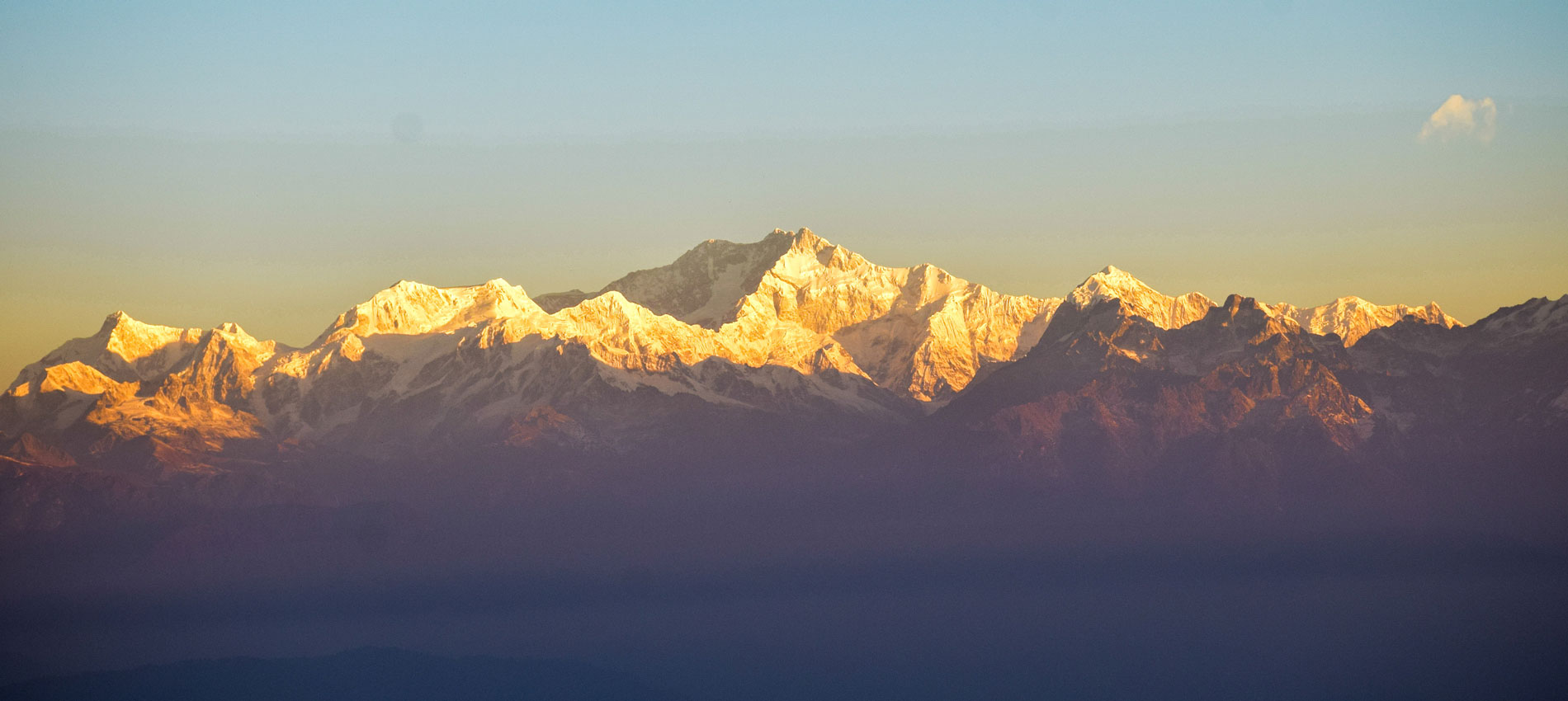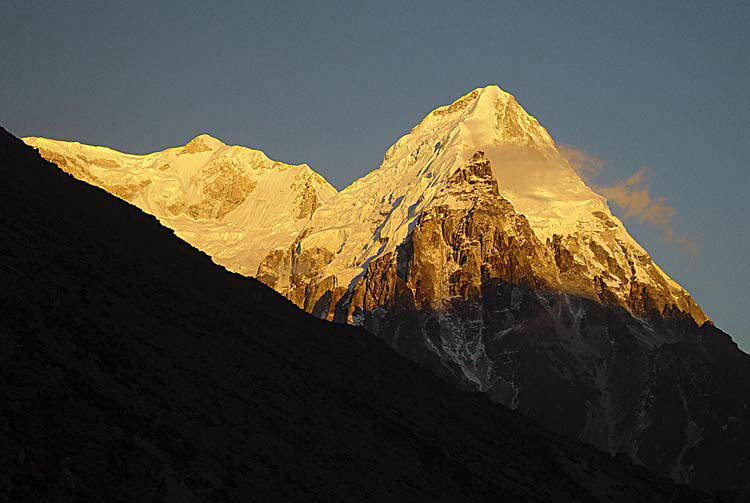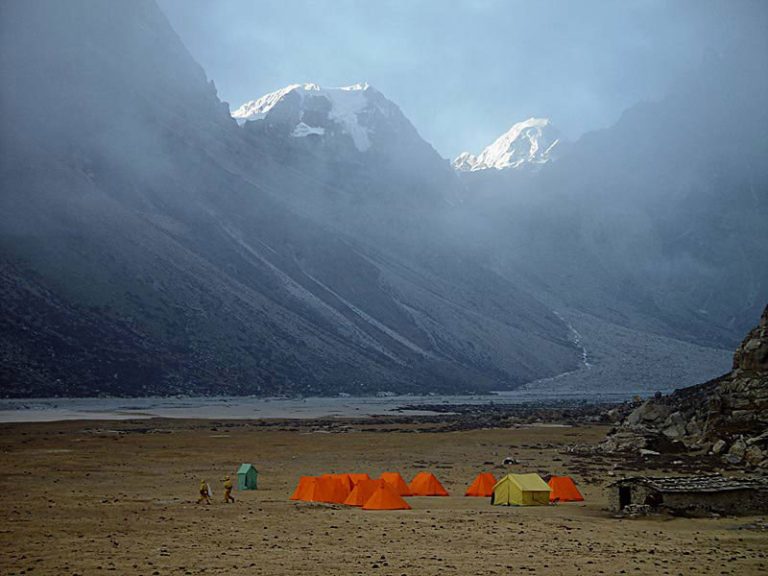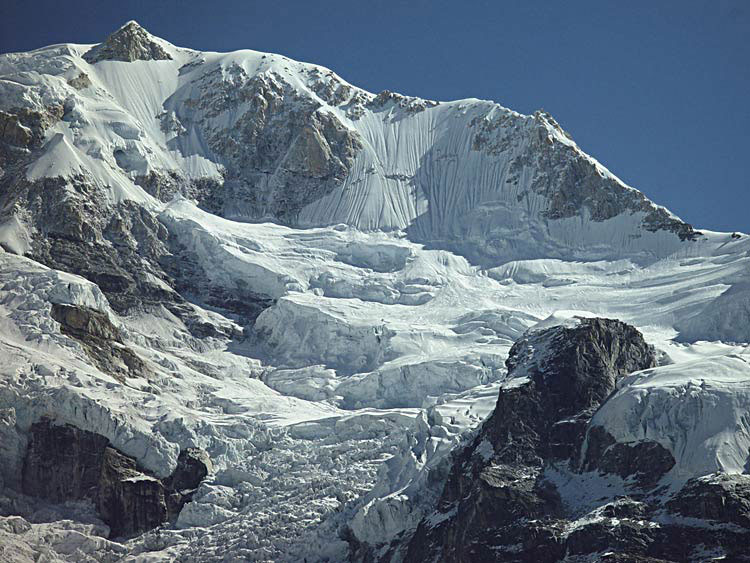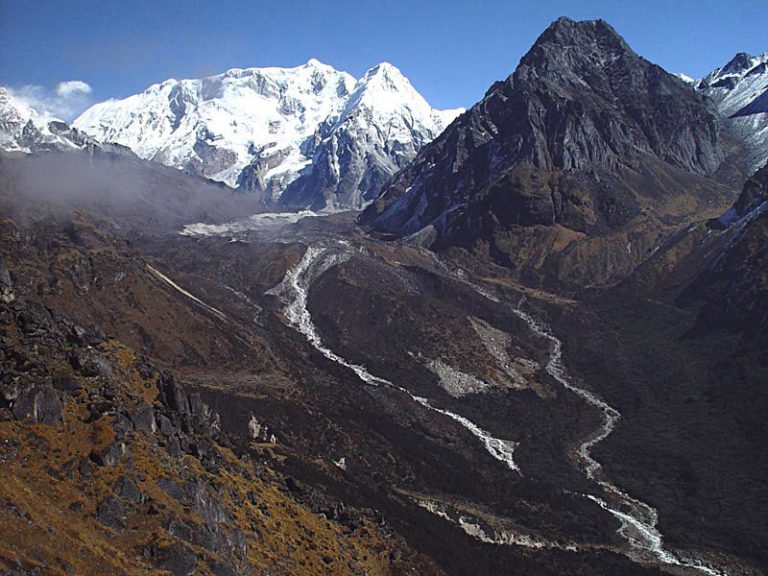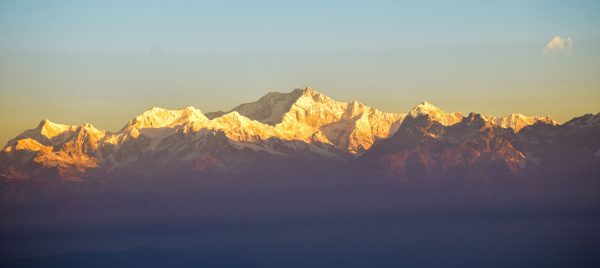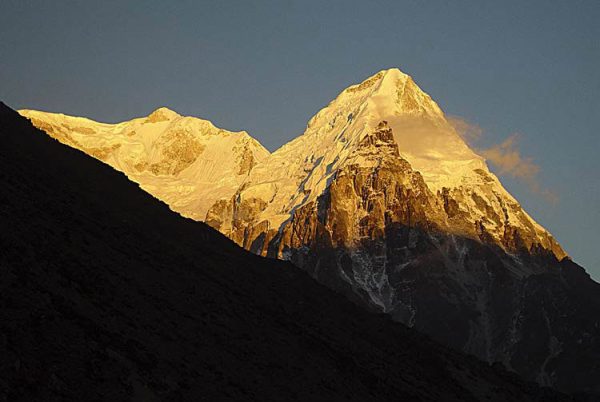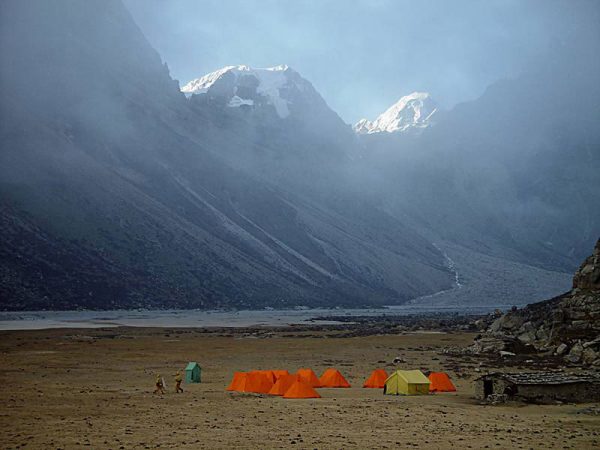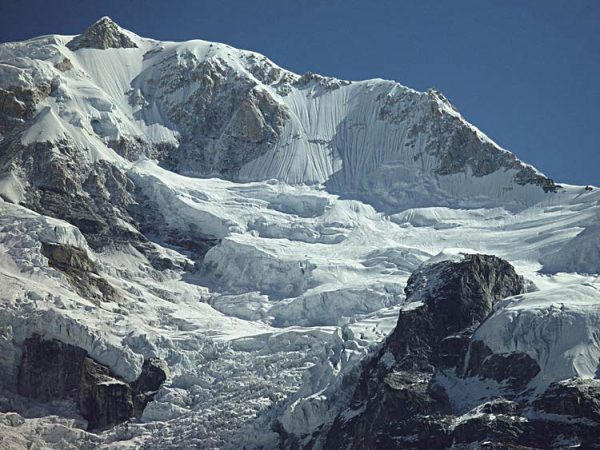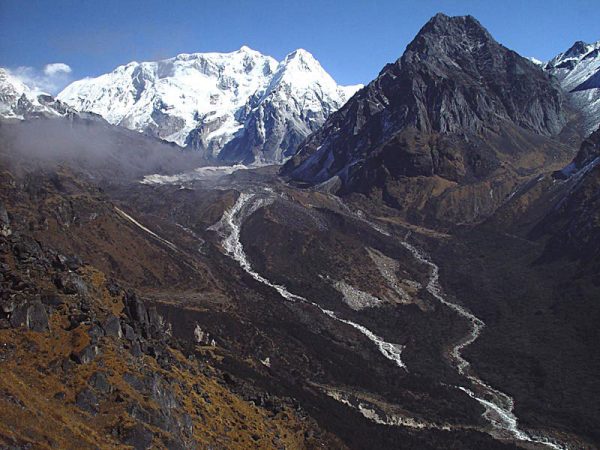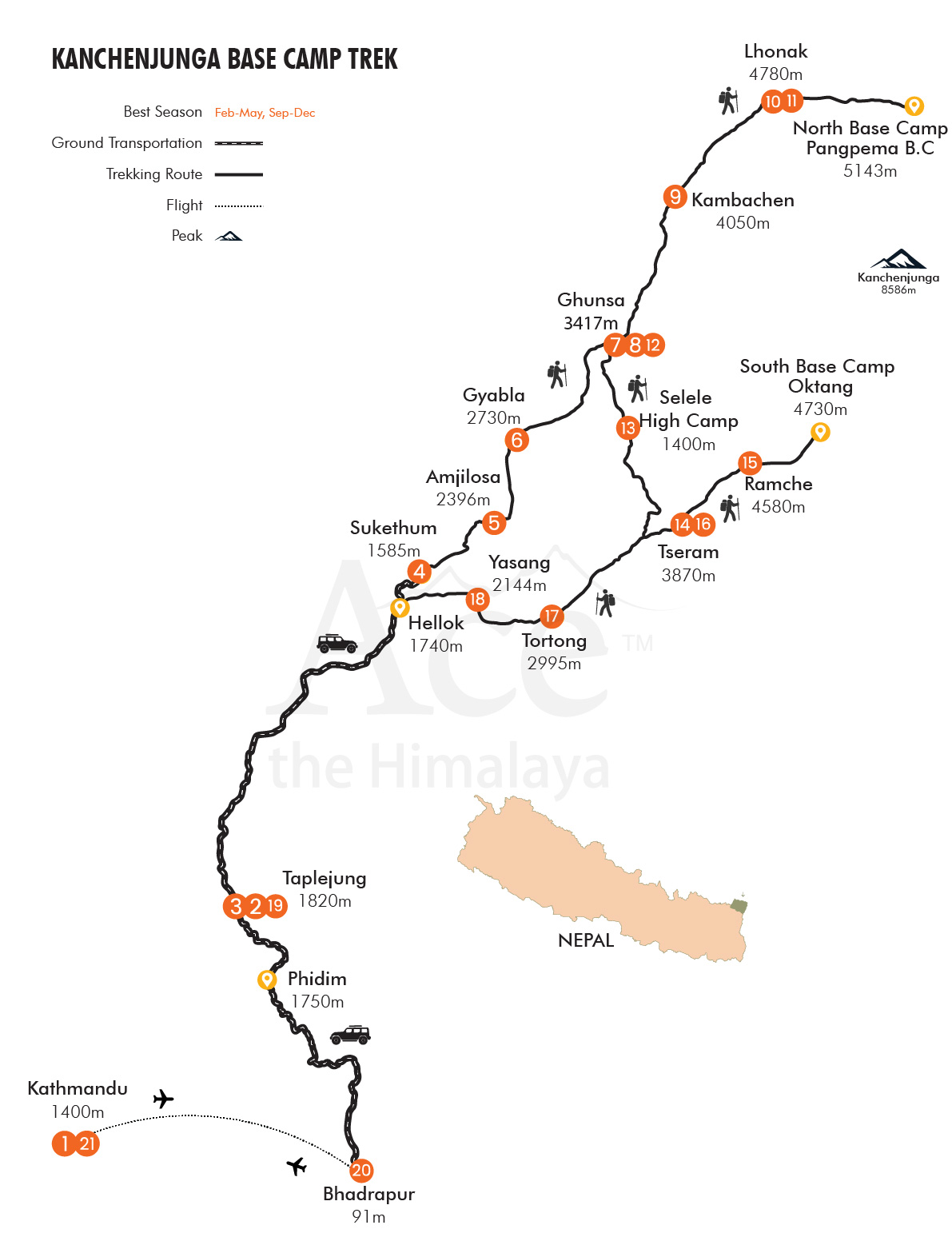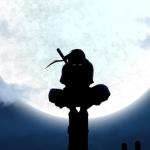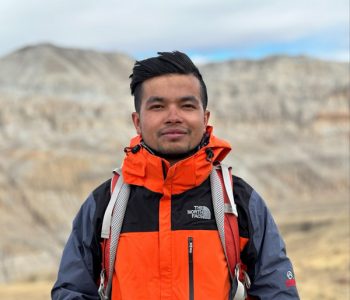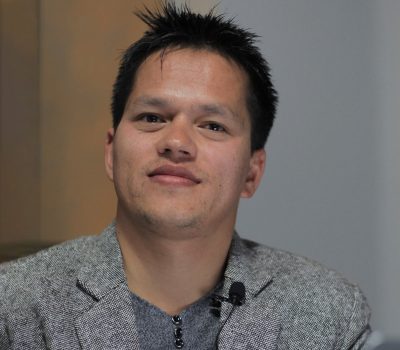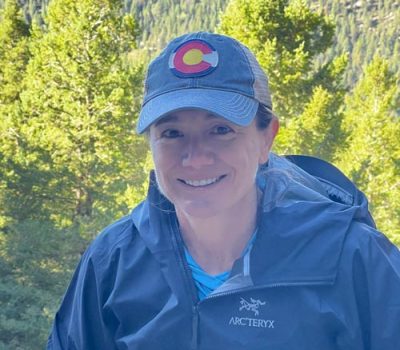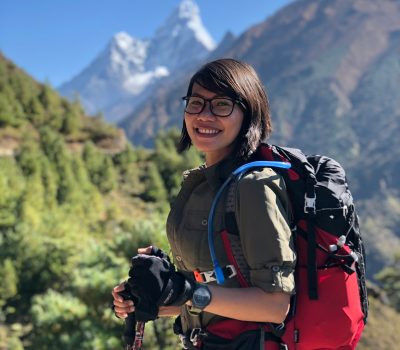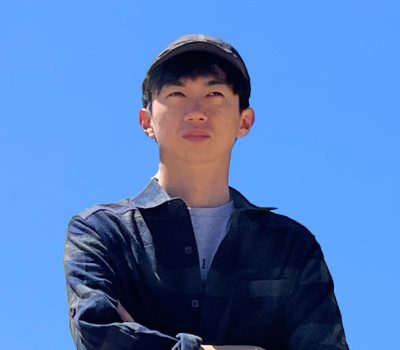Kanchenjunga Base Camp Trek - 22 Days
Price on Request
Explore the remote eastern border of Nepal on the Kanchenjunga Base Camp Trek, where stunning mountain views, diverse wildlife, and a unique culture await.
Kanchenjunga Trek Highlights
- Explore the remote Kanchenjunga region, home to the world’s third-highest mountain.
- Enjoy a scenic flight from Kathmandu to Bhardrapur.
- Trek through the Kanchenjunga Conservation Area, abundant with rare wildlife and lush forests.
- Reach the North and South Base Camp of Mt. Kanchenjunga for breathtaking views of the surrounding peaks.
- Immerse yourself in the Tibetan Buddhist culture and visit ancient monasteries along the trail.
- Experience an off-the-beaten-path adventure with fewer trekkers, pristine landscapes, and unspoiled villages.
- Witness the majestic Yalung Glacier, a dramatic and expansive ice field.
- Encounter a diverse ecosystem, ranging from subtropical lowlands to alpine meadows.
Kanchenjunga Base Camp Trek Overview
The Kanchenjunga Base Camp Trek offers an extraordinary adventure into one of Nepal’s most remote and pristine regions, with routes leading to both the North and South Base Camps of Mt. Kanchenjunga, the world’s third-highest peak at 8,586 meters.
The trek begins in the far eastern Himalayas, taking you deep into the Kanchenjunga Conservation Area, where the diverse ecosystem is home to rare wildlife such as the snow leopard, red panda, and Himalayan black bear.
This secluded, off-the-beaten-path destination remains relatively unexplored, offering trekkers a unique opportunity to immerse in Nepal’s raw and untouched wilderness.
On both the North and South Base Camp routes, you’ll trek to Kanchenjunga through dense forests, pass pristine rivers, and waterfalls.
The trail also leads you through quaint villages, providing a glimpse into traditional mountain life and cultures preserved by Tibetan Buddhist communities, who practice their centuries-old rituals and extend warm hospitality to visitors.
The South Base Camp trek offers a close encounter with the Yalung Glacier and impressive views of Kanchenjunga’s south face.
You’ll visit high passes and cross rugged terrain to reach the South Base Camp, a less frequented yet equally mesmerizing site.
The remoteness of this trek requires special permits and a guided team, ensuring that only a few adventurers take on this route every season.
The isolation amplifies the serenity of the region, with vast landscapes to yourself and little interference from the modern world. The journey to Kanchenjunga trek brings peace to the soul, as the pristine environment, simple village life, and towering mountain views combine to create a trek unlike any other.
The Kanchenjunga Base Camp Trek is a challenging adventure, requiring prior trekking experience and physical endurance. You’ll journey through remote Himalayan trails, exploring hidden corners rich in natural beauty and cultural heritage, offering a timeless and rewarding experience.
Kanchenjunga trek is not just a journey through nature but an expedition into Nepal’s best-kept secret, a place where adventure, solitude, and beauty converge to create a life-changing experience.
Short Itinerary
Arrive in Kathmandu (1,400 m/4,593 ft). Overnight in a 3-star hotel.
Fly from Kathmandu to Bhadrapur (91 m/299 ft) – 45-minute flight, then drive to Fiddim (5 to 6 hours) or Taplejung (1,820 m/5,971 ft) (8 to 9 hours). Overnight in a guesthouse.
Spare day in Taplejung in case of flight delays. Overnight in a guesthouse.
Drive from Taplejung to Sukethum (1,585 m/5,200 ft) – 4 to 5 hours. Overnight in a guesthouse.
Trek from Sukethum to Amjilosa (2,396 m/7,861 ft) – 6 to 7 hours. Overnight in a guesthouse.
Trek from Amjilosa to Gyabla (2,730 m/8,957 ft) – 4 to 5 hours. Overnight in a guesthouse.
Trek from Gyabla to Ghunsa (3,417 m/11,211 ft) – 4 to 5 hours. Overnight in a guesthouse.
Acclimatization day in Ghunsa (3,417 m/11,211 ft). Overnight in a guesthouse.
Trek from Ghunsa to Kambachen (4,050 m/13,287 ft) – 4 to 5 hours. Overnight in a guesthouse.
Trek from Khambachen to Lhonak (4,780 m/15,682 ft) – 4 to 6 hours. Overnight in a guesthouse.
Trek from Lhonak to Pangpema (North) Base Camp (5,143 m/16,873 ft) and back to Lhonak – 6 to 8 hours. Overnight in a guesthouse.
Trek from Lhonak to Khambachen for lunch, then return to Ghunsa (3,417 m/11,211 ft) – 6 to 8 hours. Overnight in a guesthouse.
Trek from Ghunsa to Selele High Camp (4,200 m/ 3,780 ft) – 3 to 5 hours. Overnight in a guesthouse.
Trek from Selele High Camp to Tseram (3,870 m / 12,697 ft) via three passes – 3 to 5 hours. Overnight in a guesthouse.
Trek from Tseram to Ramche (4,580 m/15,026 ft) – 3 to 4 hours. Overnight in a guesthouse.
Trek from Ramche to Oktang (South) Base Camp (4,730 m/15,518 ft) and back to Tseram – 5 to 7 hours. Overnight in a guesthouse.
Trek from Tseram to Tortong (2,995 m/9,826 ft) – 4 to 5 hours. Overnight in a guesthouse.
Trek from Tortong to Yasang (2,144 m/7,034 ft) – 5 to 6 hours. Overnight in a guesthouse.
Trek from Yasang to Hellok, then drive to Taplejung (1,820 m/5,971 ft) – 2 to 3 hours trek and 4 to 5 hour drive. Overnight in a guesthouse. duration as well
Drive from Taplejung to Bhadrapur, then fly back to Kathmandu. Overnight in a 3-star hotel.
Spare day in case of flight delays. Overnight in a guesthouse.
Transfer to the International Airport for your final departure.
 Note
Note
Our standard itinerary might differ slightly due to unpredictable happenings and events out of our control. Factors such as flight cancellation/delay, unfavorable weather, natural calamities, newly implemented government rules, political affairs, trekkers’ health conditions, etc., are possible. Evaluating the situation’s possible solutions allow the trekking to resume as much as possible based on the best alternatives. In these times, we look for your cooperation and flexibility.
It is advised you arrive one day before the trip start date so you can rest, and it also gives you time to buy clothing, equipment, and gear required for the trek. Also, it is best if you book your flights with spare days in Nepal for this trek in case of any flight delays or cancellations. Moreover, you have options to customize this trip where you can add on a sightseeing tour in Kathmandu, Pokhara, other adventure sports, or day trips around the country before or after the trek.
Departures & Availability
We do not have fixed departure date for this trip. This trip can only be organized upon your request. There is an option of private and tailor-made journey best suited for you, your family and friends. We have price discounts according to the group size, the bigger your group, the bigger your group discounts. We allow complete flexibility on your departure date, please choose your preferable date.
Kanchenjunga Trek Package Includes
Accommodation
- Twin-sharing/double accommodation in a 3-star hotel in Kathmandu for 2 nights including breakfast (Private room accommodation can be organized at an extra cost)
- Twin-sharing/guesthouse accommodation for 19 nights during the trek.
Meals & Drinking Water
- All your standard meals during the trek (Breakfast, Lunch, and Dinner) including seasonal fruits
- A farewell dinner on the last night in Nepal
- Purified drinking water during the trek using water filter or water purification tablets.
Transportation
- All (international and domestic) airport transfers on a tourist vehicle
- Two-way domestic flight cost between Kathmandu and Bhadrapur including airport departure taxes.
- All surface transfers in a private jeep.
Guide and Staff
- Experienced, first-aid trained, government licensed, English speaking, and locally recruited Ace the Himalaya’s trekking guide (2 guides for group size more than 7 people)
- Porters during the trek for carrying luggage (1 porter for every 2 clients)
- Wages, accommodation, meals, gear, insurance, and medications for all staff
Permits
- Kanchenjunga Conservation Area Permit (KCAP)
- Restricted Area Permit (RAP)
Benefits and Takeaways
- 1 Ace the Himalaya’s duffel/kit bag, trekking map, sun hat, Buff (Neck Gaiter)
- Trip completion certificate
Administrative & Taxes
- All administrative expenses and government taxes
Price Excludes
- Meals (lunch and dinner) in Kathmandu
- International flight fare and airport departure tax
- Nepal Entry Visa (Visa can be acquired easily after your arrival at Tribhuvan International Airport in Kathmandu with a fee of USD 30 for 15 days visa, USD 50 for 30 days visa and USD 125 for 90 days visa)
- Travel insurance along with high-altitude emergency evacuation coverage
- Any beverages including bottled and boiled water
- Tips to trekking staff and driver
- Personal trekking gear and equipment
- Any expenses other than the Price Include section
Kanchenjunga Base Camp Trek Itinerary
Expand AllDay 01: Arrive in Kathmandu
Upon your arrival at Tribhuvan International Airport, a representative will meet you and transfer you to your hotel in the heart of Kathmandu. After check-in, you can take some time to relax or explore the vibrant streets of Thamel.
If time permits, you may want to visit some nearby attractions such as the Garden of Dreams or the bustling Asan market, rich in cultural heritage.
Day 02: Fly from Kathmandu to Bhadrapur then drive to Fiddim or Taplejung
After breakfast, you’ll catch an early morning flight from Kathmandu to Bhadrapur, a small city in the southeastern plains of Nepal. From Bhadrapur, the journey continues by jeep through picturesque landscapes of terraced hills and small villages.
Depending on the road conditions and time, you’ll either stop in Fiddim or drive further to Taplejung, the starting point for many Kanchenjunga treks. As you ascend, the scenery transitions from tropical lowlands to lush green hills, with panoramic views of the surrounding mountains.
Day 03: Spare day in Taplejung in case of flight delays
Today is set aside as a buffer day in Taplejung to accommodate any potential flight delays, which are common in this region due to unpredictable weather conditions. Taplejung, located in the eastern part of Nepal, is a quaint town offering an opportunity to explore its local charm and peaceful surroundings.
If flights are on schedule and the day is free, you can spend your time exploring the local markets or visit nearby points of interest.
You can also spend this extra day on optional hikes around Khambachen which allows you to acclimatize better and prepare for the upcoming journey in the Kanchenjunga region.
Day 03: Drive from Taplejung to Sukethum
After breakfast in Taplejung, you’ll drive through charming villages like Mitlung and Chirwa, passing rivers and dense forests as you head towards Sukethum. The drive takes you alongside the Tamor River, with occasional stops for refreshments and to admire the changing scenery.
Along the way, you will pass through the Kanchenjunga Conservation Area, where permits are checked. Upon arrival at Sukethum, you’ll settle into a local guesthouse and enjoy the peaceful surroundings of this riverside village.
Day 05: Trek from Sukethum to Amjilosa
Your Kanchenjunga trekking adventure begins in earnest today! Starting from Sukethum, the trail winds along the Ghunsa Khola, with numerous suspension bridges offering thrilling crossings over the rushing river below.
The trek takes you through dense forests filled with bamboo, rhododendron, and ferns, offering a peaceful walk amidst nature.
After ascending through narrow gorges and past small settlements like Jongim and Ghaiyabari, you’ll arrive at Amjilosa, a tiny village perched on the mountainside.
Day 06: Trek from Amjilosa to Gyabla
After breakfast, the trail ascends gradually through a lush forest of oak, pine, and bamboo. Today’s trek brings the possibility of spotting wildlife like the elusive red panda.
The path climbs steadily, revealing stunning views of waterfalls cascading down the mountainsides. The trek continues through quiet forests with no signs of human habitation until you reach Gyabla, a small settlement nestled among the hills.
Day 07: Trek from Gyabla to Ghunsa
Leaving Gyabla, the trail gradually descends towards Phale, a Tibetan refugee village where you’ll notice prayer flags fluttering in the wind and ancient mani walls carved with Buddhist inscriptions.
From Phale, the trail heads north through pine and rhododendron forests, with the ever-present Ghunsa Khola flowing beside you.
After several hours of walking, you’ll reach the large, picturesque village of Ghunsa, which serves as a popular rest stop for trekkers. Here, you can explore the local gompa (monastery) and interact with friendly villagers.
Day 08: Acclimatization day in Ghunsa
Today is an essential acclimatization day in Ghunsa to help your body adjust to the increasing altitude. You’ll take a short hike to a nearby ridge or viewpoint, offering spectacular views of the surrounding snow-capped peaks, including the majestic Mt. Jannu.
The rest of the day is free to explore Ghunsa, visit the local monastery, or relax by the river. Proper acclimatization is crucial as you continue to gain altitude in the coming days.
Day 09: Trek from Ghunsa to Khambachen
Today’s trek takes you higher into the alpine zone, with the landscape gradually shifting from forested hills to open, rocky terrain. You’ll pass through several landslide-prone areas, so careful footing is required.
Along the way, keep an eye out for blue sheep and perhaps even a snow leopard. The views of Mt. Jannu (7,710 m) are breathtaking as you approach the small settlement of Khambachen, where a few teahouses offer basic accommodation.
Day 10: Trek from Khambachen to Lhonak
The trek today takes you closer to the Kanchenjunga glacier, moving through a remote and rugged landscape. The trail is challenging, with some steep ascents and the occasional scramble over rocky terrain.
As you gain altitude, the views become even more magnificent, offering glimpses of towering peaks like Wedge Peak, Mera, and Twins.
The final stretch to Lhonak is a relatively easy walk across a moraine plateau, where you’ll find a few teahouses. Lhonak is a small settlement, serving as a base for those heading to the north Kanchenjunga Base Camp.
Day 11: Trek from Lhonak to Pangpema (Kanchenjunga North) Base Camp and back to Lhonak
Today’s trek is the highlight of the Kanchenjunga North Circuit. You’ll start early in the morning, following the trail along the lateral moraine of the Kanchenjunga Glacier. The ascent is gradual but long, and the higher you climb, the more spectacular the views become.
As you approach Pangpema also known as Kanchejunga North Base Camp, the third-highest mountain in the world, Mt. Kanchenjunga (8,586 m), towers above you, flanked by numerous other majestic peaks.
After spending some time at the base camp, soaking in the incredible vistas, you’ll return to Lhonak for the night.
Day 12: Trek from Lhonak to Khambachen for lunch, then return to Ghunsa
Today, you’ll retrace your steps back down the trail, descending from Lhonak to Khambachen for a lunch break. The return journey allows you to appreciate the views from a new perspective, and you’ll likely pass by familiar landmarks, such as the striking Mt. Jannu.
After lunch, continue on to Ghunsa, where the lower altitude will provide relief and a restful night after the longer trekking days.
Day 13: Trek from Ghunsa to Selele Camp
After a restful night in Ghunsa, you’ll begin your trek to Selele Camp. The trail climbs steeply through lush forests, with moss-covered trees and occasional clearings that offer stunning views of the surrounding mountains.
As you approach the high camp, the terrain becomes more barren, with rocky outcrops and panoramic vistas of the snow-capped peaks.
Selele Camp is a remote spot, with minimal facilities but extraordinary natural beauty. This is a short yet vital trek to prepare you for the high-altitude passes that lie ahead.
Day 14: Trek from Selele Camp to Tseram (3,870 m/ 12,697 ft) via three passes
Today is a thrilling day of trekking as you cross three high mountain passes: Sinion La (4,400 m/14,436 ft), Mirgin La (4,663 m/15,298 ft), and the highest, Sinelapche Bhanjyang (4,785 m/15,698 ft).
The ascent to each pass is steep, but the effort is rewarded with breathtaking panoramic views of the Himalayan giants, including Mt. Everest, Makalu, and Lhotse, as well as the imposing Mt. Jannu and Kanchenjunga.
After crossing the final pass, you’ll descend to Tseram, where you can rest and reflect on the day’s adventure.
Day 15: Trek from Tseram to Ramche
Today’s trek is relatively short, but the views are no less spectacular. You’ll follow the trail along the Yalung Glacier, with the towering peaks of Rathong (6,682 m) and Kabru (7,412 m) dominating the skyline. The trail is surrounded by glaciers and icefalls, creating a dramatic and awe-inspiring landscape.
You’ll reach Ramche, a small settlement that serves as a base for exploring the southern Kanchenjunga region. After a brief rest, you may want to take a short hike to explore the nearby glacial lakes and ridges.
Day 16: Trek from Ramche to Oktang (Kanchenjunga South) Base Camp and back to Tseram
An exciting day lies ahead as you trek to the Oktang (South) Base Camp, also known as Yalung Base Camp. The trail follows the Yalung Glacier, leading you to the viewpoint of the southern face of Kanchenjunga.
Here, you’ll be treated to breathtaking views of the three main summits of Mt. Kanchenjunga, along with surrounding peaks like Kabru and Rathong. After taking in the dramatic scenery at the Kanchenjunga base camp, you’ll return to Tseram for the night.
Day 17: Trek from Tseram to Tortong
Leaving the high-altitude landscape behind, you’ll descend into the verdant forests of rhododendron and pine. The trail follows the Simbuwa Khola as it winds through the valley, offering tranquil views of the surrounding hills and rivers.
The descent is a relief after the strenuous days of trekking, and the lush surroundings provide a peaceful atmosphere. You’ll arrive at Torangdin, a small village nestled in the valley, where you’ll spend the night.
Day 18: Trek from Tortong to Yasang
Today’s trek takes you back uphill through a series of small villages and dense forests. The trail climbs gradually, passing through terraced fields and traditional settlements, with the occasional glimpse of snow-capped peaks in the distance.
The village of Yasang, perched on a ridge, offers stunning views of the surrounding valleys and mountains. The higher altitude here signals your approach to the final days of the trek.
Day 19: Trek from Yasang to Hellok, then drive to Taplejung
Today’s trek begins with a gradual descent through lush forests, passing small villages where you can witness the local lifestyle. As you follow the Tamor River, the landscape transitions from alpine terrain to a more temperate environment.
The walk from Yasang to Hellok is relatively short, about 2 to 3 hours, with plenty of opportunities to enjoy the natural beauty of eastern Nepal. Once at Hellok, a jeep will be waiting for the drive back to Taplejung.
The drive takes you past the picturesque hillsides and terraced farmlands typical of the region, giving you a chance to reflect on the extraordinary journey.
Day 20: Drive from Taplejung to Bhadrapur, then fly back to Kathmandu
After an early breakfast, you will begin the long, scenic drive from Taplejung to Bhadrapur. The road winds through terraced landscapes, tea gardens, and rural villages, offering spectacular views of Nepal’s countryside.
Upon reaching Bhadrapur, you’ll take a short flight back to Kathmandu. Once you arrive in the capital, you’ll have time to relax or do some last-minute sightseeing or shopping before your final departure.
In the evening, you will have a farewell dinner with your guide.
Day 21: Spare day in Bhadrapur in case of flight delays
Today serves as a buffer day in Bhadrapur to accommodate any potential flight delays back to Kathmandu. If flights are on schedule, you can relax at your hotel in Kathmandu and explore the city.
In the meantime, you can rest and enjoy the tranquil atmosphere of this lowland town as you prepare for your journey home.
Day Transfer to the international airport for final departure:
After breakfast, our representative will transfer you to Tribhuvan International Airport for your final departure, bidding you farewell as you embark on your onward journey with memories of the majestic Kanchenjunga Base Camp trek.
Packing List for Kanchenjunga Trek
Here is a list of what you might want to pack for the Kanchenjunga Base Camp Trek. Please take this as a starting point. You’ll need layers of warmer clothing during the winter. We provide a 75 liter duffel bag for you to use for the trek. It will be given to you during your pre-trip meeting in Kathmandu. The duffle bag is yours to keep. Also, you can rent sleeping bag and down jacket with us at the additional fee of USD 35 for each once you are in Kathmandu.
General
- Four-season (zero degree) sleeping bag (We have rental sleeping bags available for an additional USD 35)
- Puffy down jacket (We have rental jackets available for an additional USD 35)
- Daypack (35-45 liters recommended) with rain cover
- Sleeping bag liner
Upper Body
- Sun hat or cap (We'll provide you with a free Ace the Himalaya baseball cap.)
- Knitted hat/Beanie
- Headlamp
- Sunglasses
Torso
- Technical fabric base layer (light for warmer months, heavy for colder months)
- Technical fabric short (2) and long sleeve (2) shirts
- Waterproof, windproof shell
- Fleece jacket or pullover
Lower Body
- Technical fabric base layer (light for warmer months, heavy for colder months)
- Hiking pants (2)
- Comfortable pants for inside the teahouses
- Waterproof, windproof shell
- Hiking shorts
Hands
- Wool or technical fabric liner gloves
- Hard-shell outer gloves (insulated for colder months)
Feet
- Wool or technical fabric warm socks
- Hiking socks
- Liner socks (optional such as silk)
- Trekking/hiking boots (waterproof recommended)
- Ice Cleats /Micro Spikes
- Casual shoes
- Gaiters (lightweight for dust or heavy for snow in colder months)
Undergarments
Note: The quantity of each article of clothing can be adjusted to suit the preferences of each participant.
- Technical fabric/quick drying is best for underwear (opportunities to launder during the trip)
- Sports bras (women)
- Pajamas or sleeping clothes
First Aid Kits and Medications
- (Note: Guides carry medications and first aid kits during the trip. However, personal kits and medications are highly recommended.)
- Sunscreen
- Lip balm
- ointment
Other Essentials
- Passport
- Extra copies of passport-sized photos
- Reusable water bottle
- Toiletry kits
- Water purification tablets or UV water purifier (if you plan to treat water)
- Hydration bladder
- Towel
- Pillowcase
- Toilet paper (2 rolls)
- High protein snacks (such as protein bars or nuts)
- Waterproof/dry bags for carrying important documents and money
- Airline tickets (Please leave a copy at our office in Kathmandu. This can be useful if there is a change in the date of the flight.)
- Earplugs
- Trekking poles
Optional
Once in Nepal, if you have the time, you can purchase supplies and gear for hiking. Thamel, Kathmandu’s tourist hub, is home to many shops where you can get a variety of reasonably priced trekking equipment.
- Power bank or extra batteries
- Cameras and mobile phone
- Cards/book
- Binoculars
- Whistle
- Thermos for hot water
Important Information
- We give you a free duffel bag and baseball cap during your pre-trip meeting in Kathmandu. The duffel bag will be used to pack your trekking supplies.
- For every two participants, we assign one porter. The duffel bag, which should weigh around10 kg/22 lbs, will be carried by the porter throughout the walk.
- To carry your daily necessities like cash, crucial papers, a water bottle or bladder, a camera, toiletries, sunscreen, a notebook, clothing, etc., you must have your own daypack (with a waterproof cover).
- You can store your luggage (non-trekking items) at the hotel in Kathmandu.
- A down jacket with a hood is a must for altitudes above 4,000 m to keep warm. You can rent a down jacket for USD 35. Please note that in case of loss or damage, you need to reimburse the cost of USD 200 per item.
- You can rent a 4-season sleeping bag for USD 35. Please note that in case of loss or damage, you need to reimburse the cost of USD 200 per item.
Note: Some clothing, especially form-fitting, figure-hugging items made of elastic material (like yoga pants), may offend locals. Therefore, if you choose to wear these clothes for comfort, please make sure to wear something over them.
Trip Video
FAQs for Kanchenjunga Base Camp Trek
General
Why trek with Ace the Himalaya?
Ace has a reputation for successfully leading treks with knowledgeable leaders and staff taking care of all your travel needs. We are a certified sustainable travel company that also endorses the idea of giving back to the community by participating in various philanthropic activities. Here are 17 reasons why you should choose Ace the Himalaya for your next adventure!
Is Nepal open to travelers following the Covid-19 pandemic?
Indeed, Nepal is entirely open. Travelers are welcome in Nepal without any restrictions. Arriving travelers can obtain a visa on arrival at the Kathmandu airport as well.
What are the conditions to travel to Nepal post Covid-19?
Traveling to Nepal is now hassle-free. You don’t need a vaccination certificate or negative PCR test, but check with your airlines and transit countries for any specific requirements.
We suggest you look at the Nepal immigration site https://www.immigration.gov.np for the most up-to-date information.
What additional documents do I need?
- Two passport-sized photos (2×2 inch) to give to our office staff
- A copy of your international flight ticket to give to our office staff
- A copy of travel insurance to give to our office staff
What should I know about booking my flights to/from Nepal? Do I need to plan extra days in case of delays?
The best course of action is to add a day or two before and after your intended trek days in case of flight delays or cancellations. It also gives you time to buy clothing equipment and gear required before your trip.
Please be aware that Ace the Himalaya is not responsible for any inconveniences or missed international flights resulting from unforeseen events like airport changes, flight delays or cancellations, etc.
Is hiring a guide necessary even if I have trekking experience?
Yes, hiring a guide is essential for the Kanchenjunga Base Camp trek. As a restricted area, the trek requires a registered guide and a minimum of two people in a group.
Even for experienced trekkers, navigating the remote trails and managing permits can be challenging. Our expert guides ensure safety, handle logistics, and make the journey smoother, allowing you to focus on enjoying the trek.
Can the guide speak English?
Yes, our guides can speak English. Most of them start their careers as porters and work for 3 to 4 years before becoming trekking guides. Their English skills are based on real-world experience rather than formal education. While they are able to communicate effectively, please note that English is not their first language, so their fluency may not be on par with native speakers. They will also assist with communication, especially since many locals, like shopkeepers and teahouse hosts, may not speak English.
Weather and Temperature
What is the best season for Kanchenjunga Base Camp trek ?
The best seasons to do this trek are autumn (Mid-September to November) and spring (March to early June). This trek is possible year-round, and we can organize it when it suits your schedule.
However, we generally suggest doing this trek in the favorable seasons and keeping away from the rainstorm season (July and August). In the cold months of January and February, the temperature can be a little harsh in the mountains.
However, some prefer to travel during these months as it is less crowded given that you are well prepared with appropriate winter wear and other gear.
What kind of weather and temperature can I expect while trekking?
The Kanchenjunga region, experiences diverse temperatures across its seasons due to its high altitude. The weather varies significantly between spring, autumn, and winter, offering distinct conditions for each period.
Spring (March to May)
During spring, the Kanchenjunga region experiences cool but gradually warming weather. Daytime temperatures can reach a maximum of 15°C (59°F), while nighttime temperatures at higher altitudes can drop to -10°C (14°F).
Autumn (September to November)
Autumn offers the most pleasant conditions with clear skies and mild temperatures. The daytime maximum is around 10°C to 12°C (50°F to 54°F), and nighttime temperatures can fall to -15°C (5°F) at higher elevations.
Winter (December to February)
Winter brings extreme cold to the Kanchenjunga region. During the day, temperatures can reach 5°C (41°F), but at night, especially in the mountains, they can drop as low as -25°C (-13°F) or lower, with heavy snowfall common at higher altitudes.
What is the temperature rating of the sleeping bag that you lend to trekkers?
The temperature rating of the sleeping bags that we rent to trekkers is about -10°C (14°F). Also, our guides can obtain extra blankets if needed at the teahouses.
Arrival and Visas
Is it possible to obtain a visa for Nepal upon arrival at the airport?
Yes, you can obtain a Nepal visa upon your arrival at the airport. There are kiosks in the arrival hall that you use to complete the necessary forms. The cost is USD 30 for a 15-day tourist visa, including numerous entries, or USD 50 and USD 125 for a 30-day or 90-day tourist visa including numerous entries respectively. You should carry cash (USD) with you to pay your visa fees quickly and easily, as digital payments are frequently unavailable.
To save time, we recommend filling out the online visa application form in advance. Applying online 2 weeks before your arrival will expedite the process at the airport. For detailed guidelines, please refer to our blog titled Guidelines for Online Tourist Visa Form in Nepal.
Who will come to pick me up at the airport upon my arrival?
Our staff will be waiting for you outside the airport terminal with our signboard (Ace the Himalaya). You will be accompanied to a hotel in a private tourist vehicle.
Payments and Extra Costs
How much additional money do I need per day?
Typically, USD 15 to 20 per person per day will be sufficient. This is to purchase water, tea/espresso, snacks, and hot showers in the mountains and for lunch or dinner in Kathmandu. Additionally, if you want to buy souvenirs or native Nepali goods, you can bring extra cash with you.
Is it possible to use credit cards in the places I visit during the trek?
In Kathmandu, yes. Once you are out of the city, all you need is cash. Please change the currency to local Nepali Rupees before you go to the mountains
Is it possible to reserve a trip now and pay a deposit later, or do I have to pay a deposit at booking/reservation?
When you book, you must pay a 30% deposit to secure your itinerary. The remaining balance can be paid upon your arrival at Kathmandu or before arrival. US Dollars cash and credit cards (Visa, Master, and American Express) are accepted once in Nepal. Please note a 4% transaction fee will be added for all credit card transactions.
How do I pay the remainder of my balance upon arrival in Kathmandu? US Dollars cash or credit card?
You can make payments via US Dollars cash or credit card (Visa, Master, and American Express). A 4% transaction fee is added if paying with a credit card. Thus, we encourage you to pay with USD cash if you are planning to pay upon your arrival in Kathmandu.
We prefer you pay with larger bills (USD 50 or 100). Please note that the cash should not be older than 2009 and in good condition, as banks do not accept worn, torn, or crumpled bills.
How are the ATM and money exchange facilities in Kathmandu?
There are ATM and money exchange facilities almost every few meters in Thamel, where you will be staying in Kathmandu. So, you can easily use your cards to cash out limited sum of money to which a minimum charge is deducted by the ATM facility itself. You can easily exchange your foreign currencies in currency exchange centers for an exact rate.
Who Can Trek?
Do I need prior trekking experience?
Previous trekking experience is not required if you are physically healthy and have enough enthusiasm for the trek.
Are there any age requirements for mountain trekking?
Our treks have no age restrictions if members are healthy and willing. We have had families with kids as young as 5 years do the treks along this region, and our oldest adventurers have been in their late 70s.
Is trekking to mountain regions safe for solo female travelers?
It is safe for a female to trek alone in Nepal. Nepal is usually regarded as a safe nation for female visitors traveling alone. It is entirely safe for a solo woman to trek with Ace the Himalaya on any of our treks.
Physical Fitness
How challenging is the trek?
The Kanchenjunga trek is somewhat challenging due to the altitude and long duration of the trek. It is a strenuous journey that comprises walking 5 to 8 hours a day. Any person suffering from a pre-existing medical condition or disease must seek medical advice before considering any trek. Whilst on the trek, it is common to experience some discomfort before being fully acclimatized.
How quickly do you walk on the trail?
The average walking speed for a reasonably fit person is 4 kilometers per hour. At higher elevations, it is highly recommended that you walk slowly to help with acclimatization.
What kind of physical training is necessary for trek preparation?
For trekking, you must prepare your body to walk over uneven, hilly landscapes while carrying a backpack. Walking at an incline, jogging, cycling, and going for long-distance hikes are all good ways to exercise. You should work out for at least one hour four to five times a week for at least two months before trekking.
What are the physical standards that I need for the trek?
Participants in good physical condition should be able to complete this trek. If you are not physically active, we advise starting an exercise regimen two months before the trek that includes at least an hour of walking at an incline, running, or biking four to five times a week.
Incorporating hiking into your workouts is ideal. It is advised to speak with a doctor before making travel arrangements if you have any health conditions that could affect your ability to complete the trek.
Trek Preparation and Packing
What are the procedures after I make my deposit?
After making the deposit, one of our staff will email you for further information. We will require a copy of your passport photo page and your arrival/departure flight details. We will also provide you with additional trip information.
What sort of insurance do I need? How can I obtain a policy?
Travel insurance is mandatory for our hiking itineraries. We require your policy have medical evacuation coverage for the maximum elevation of your itinerary. Insurance may also cover additional costs in the event of a flight delay or cancellation caused by bad weather, medical costs, theft, loss, and damage to your items while traveling.
Travel insurance can be obtained online by one of several travel insurance companies. Please note that insurance obtained from an airline at the time of booking your flight may not cover medical evacuation coverage.
What are the necessary items that I should pack for my trip?
You can find the necessary items to pack for the trek on the Equipment tab. Gear and equipment can be bought or rented upon your arrival in Kathmandu. If you plan on buying or renting gear in Kathmandu, please allow extra time.
Do you provide sleeping bags or down jackets for rent?
Yes, we do provide sleeping bags or down jackets for rental costs of USD 35 each. Do let us know before initiating the trek and we shall provide items. You can view the photos of the gear at this link: Photos of the Gear.
What type of bag will the porters carry?
We provide you with a free duffel bag of 70 to 80-liter capacity that our porters will carry. The maximum weight that porters can safely carry is 30kg, and each porter is assigned to two people.
However, each porter carries a maximum of 25 kg/55 lbs in total during the trek period. Your duffel bag, which should weigh no more than 12.5 kg/27.56 lbs per client, will be carried by the porter throughout the trek.
What type of daypack should I bring?
We suggest a 30 to 40-liter capacity daypack. Wider straps and hip belts are recommended to assist you in carrying weight evenly and reduce pain.
What about my passport, medications, and belongings?
Bring copies of your passport, insurance papers, and other essential items in your carry-on during your flight. If you need to take medications daily, keep them in your daypack with your other essential possessions. You can store other non-trekking essentials in the office of Ace the Himalaya or at the hotel in Kathmandu.
Accommodation
What kind of lodging is available in Kathmandu and on the trek?
In Kathmandu, we provide accommodation in standard rooms at three-star hotels with breakfast included.
During the trek, you will stay in basic guesthouses along the route. These lodges offer simple rooms, typically with twin-sharing beds and shared bathroom facilities.
While amenities are minimal, they provide a warm, dry place to rest and recharge after a day of trekking.
Is it possible to have private rooms while trekking or while in Kathmandu?
A private room in the teahouses cannot be guaranteed. The accommodation during the trek will remain very basic with twin sharing rooms and occasionally dormitory rooms for our trekkers.
We can, however, arrange for a private room while in Kathmandu for an additional cost of USD 35 per room per night.
What happens if I end up staying an extra night/s in Kathmandu due to an unforeseen delay or cancelation?
In case of unforeseen circumstances such as flight cancellation, your health, or for any reason you decide to discontinue the trip and arrive early in Kathmandu then you will need extra accommodations in Kathmandu. The cost of the teahouses in the mountains is not equivalent to the cost of a hotel in Kathmandu. In such cases, we will arrange your accommodations, but you will need to pay a supplemental charge.
Is it necessary to bring toilet paper for the trek?
You can buy toilet paper in the guesthouses during the trek, but it can be expensive, so we suggest you bring some with you. You also need to bring personal items such as towels, soap, hand sanitizers, and so on.
Are there restrooms along the trail?
There are toilet facilities in the teahouses/lodges during the trek. Trekkers can also find private areas along the trail for emergencies.
What sort of food can I expect in trekking?
While your breakfast is included in your package, there are a whole lot of good restaurants in Kathmandu where you can find any delight of your choice for lunch and dinner during your stay in Kathmandu.
During the trek, you will stay at guesthouses that serve simple yet nourishing meals, such as dal bhat (lentils and rice), noodles, soups, and momos (dumplings). You can also find some Western-style dishes like pasta and pancakes. Meals are usually served in communal dining areas, and while the menu options may be limited, you can expect warm and hearty meals along the trek.
I'm a vegetarian. Is that a problem?
Most of the teahouses in the mountains offer vegetarian meals. So, being a vegetarian is not a problem. Vegetarian meals are preferable to avoid food poisoning and indigestion.
Is the water okay to drink? Do I need to bring purifying tablets or filters?
Natural spring water or tap water can be found along the trek and in guesthouses but must be treated. We use Katadyn filters or water purification tablets to purify the natural water sources to make them safe to drink. This way, it is sustainable and pocket friendly as you need not buy bottled mineral water. You must carry a water bottle that can hold both hot and cold water and a hydration pack.
If the temperature drops too low for the Katadyn filter to function properly or if any technical issues occur, it is recommended to buy boiled water from the teahouse to ensure safe drinking water as an alternative.
Can we get hot or boiled drinking water? Does it cost extra?
Yes, teahouses do provide hot boiled water for an extra charge of USD 2 to 5 per liter. The cost varies and increases at higher altitudes.
Can I shower/bathe during the trek?
As it is a fully camped trek, showers can be a little hard to manage. You can however shower once you are back at your hotel in Biratnagar and Kathmandu.
Can I charge my electronic equipment during the trek?
Yes, you can charge your equipment during the trek for an additional cost. The cost will vary but is around USD 1-5 per charge. Two pins (type C) and three pins (type D) adaptors are highly recommended. Bring these adaptors or purchase them while you are in Kathmandu.
Health and Safety
Do your guides have the trekking guide certificates from the Hotel Management and Tourism Center? Have they received first aid training for high altitudes?
We provide licensed trekking guides with fluent English. Our guides are certified by the Hotel Management and Tourism Center after receiving 45 days of training. Similarly, the guides receive high-altitude training from Kathmandu Environmental Education Project (KEEP).
What are safety measures in place? What safety equipment do your guides carry on the trek to deal with sickness/accidents?
Our guides are well trained and certified in first aid. Throughout the journey, our guides will evaluate your condition and your oxygen level using an oximeter. Our head office receives continuous updates on your condition and location through the guides. In places without a phone signal, your situation will be updated through a satellite phone during emergencies.
How do you allocate guides and porters in a group?
We allocate one guide for groups of up to 8 participants. For groups of over 8 participants, we allot an associate guide. As per the size of the group, we may add more guides or divide them into sub-groups.
We provide one porter for every two clients. Two clients’ duffel bags will be carried by one porter. The weight limit is 25 kg (55 lbs) or 12.5 kg (27.56 lbs) for each client. For an additional cost, we can arrange for one porter to carry one participant’s duffel.
Is Ace the Himalaya's staff insured?
Our company insures all our trekking staff members, including guides, cooks, Sherpa, and porters. Please browse through our legal docment page to view insurance details.
What vaccinations will I need?
While no vaccinations are strictly mandatory for travel to Nepal, it is highly advisable to take precautionary measures to protect your health. To ensure a safe and enjoyable trip, we recommend the following vaccinations: Routine Vaccines, Malaria, Japanese Encephalitis, Hepatitis A, Hepatitis B, Typhoid, Rabies, Cholera, etc.
It is also helpful if you inform us of any medical condition that is relevant so we may convey this information in the event of an emergency. Ace the Himalaya keeps your medical condition confidential unless treatment is necessary.
What if I am very sick in the mountain?
Our guides are 24 hours available for the services during the trek. They are trained to use first aid kit and have knowledge to use Oxy meter. They are very much aware that higher the altitude the oxygen level gets lesser so to get updated on the oxygen level of our client and to know whether they are fit enough or needs extra precautions to continue.
Guides carry local sim cards both Nepal Telecom and Ncell in order to update whereabouts and situation of our every client. During the time of emergency our guides are alert and keeps updated to head office in Kathmandu that is available 24 /7 to arranging from horse to mules or helicopters in the must needed cases especially when client is seriously sick in the mountain and needed to be hospitalized.
How are acclimatization and altitude related?
Air at higher elevations has less oxygen available. To avoid altitude sickness, acclimatization days and slow climbs are recommended at higher elevations. Along the trek, you’ll be assisted by our professional guides in recognizing and preventing altitude sickness.
What kind of trekking boot would be best for the trek?
An important piece of equipment is your trekking boots. Invest in a durable and comfortable pair, preferably with water-proof lining. Boots that provide ankle support on rough ground and have stiff soles are recommended.
What is necessary for sun protection during the trek?
Even when the sun isn’t shining, sun protection is essential. UV rays are reflected by the snow and the harshness of the sun will damage your skin before you notice it at high elevations. Therefore, proper clothing and sunblock are necessary. Hat, sunscreen, sunglasses, clothes, etc. are vital for sun protection.
Practical Matters
What is your cancellation policy?
Notice should be provided 20 days before the trip start date in case of cancellation. The trip can be canceled for justifiable reasons. Once the trip is canceled, a fee of 30% of the trip cost is retained for administrative costs.
However, the trip amount is entirely non-refundable if the cancellation is not made before the 20 days as per our terms and conditions. For submitting a claim to your insurance company after the cancellation, we can assist with documentation such as a receipt of monies paid. Refund will not be provided for unused accommodation in case of trip cancellation caused by personal reasons/sickness/weather.
More information about our cancellation policy can be found here in Terms and Conditions page.
Do I need to tip my guide and porter? How much would that be?
Tipping is both expected and appreciated, and it reflects your satisfaction and enjoyment of the trek. We recommend tipping based on the number of participants in your trekking group and the duration of the trek. As a general guideline, consider allocating at least 10% of your total trek cost for tipping. Detailed tipping recommendations for your guides and porters will be provided during our pre-trip briefing in Kathmandu.
Is there any communication while we are trekking?
Yes, you can get a local SIM card (NTC network) for personal use. However, please note that mobile network coverage is only available up to Ghunsa and can be unreliable along the route.
Wi-Fi is accessible until Taplejung, after which it becomes unavailable and unreliable. For emergencies, we rely on satellite phones. Our guides or representatives will be happy to assist you in getting a local SIM card upon your arrival.
Does it cost an extra amount if I am a solo traveler?
If you are a solo traveler and book one of our published dates, there is no additional fee. If you sign up for a private trip or change the trip date from one of our published trip dates, you will be charged an additional fee.
Is there a provision for a refund policy if I don't accomplish the trek?
Trekkers occasionally fail to complete the journey for medical or personal reasons. In this situation, be aware that we do not issue any refunds for products purchased or unused trek days. We must pay our administration staffs, guides, and porters, purchase trekking permits, and all other booked accommodations in advance, so our expenses remain the same.
Who else will be joining my trekking group?
If there are any, you will be allocated to a trekking group. The details of the personal data of your group members cannot be disclosed. However, feel free to contact us if you have queries about other trekkers in the group and we shall give you a general idea of the ages, nationality, and sex of your group members. Chances are you will be trekking with others unless you have booked a private trip.
Can I add extra days to my trekking trip?
You can extend your trekking trip for an additional cost. Potential arrangements will be made if we get a request from your guide. This is applicable for private or solo trips as the itinerary can be easily adjusted. The addition of extra days is bound by time when you are in a group. Therefore, discuss with your group and guide, what changes can possibly be made.
I want to extend my holiday, any recommendations?
Yes, you can extend your holiday. Ace the Himalaya offers many options and alternatives for your holiday extension. For more information, you can visit our Day trips pages.
Transportation and Flights
Do I need to book my international flights for the travel to Nepal?
Yes, you must book your international flights. We are a local agency and do not make international flight arrangements. You can easily browse through flight tickets in airlines sites to book ones most feasible for you.
What form of transportation do you utilize?
We utilize private tourist vehicles for touring, city visits, and airport pickups. Based on the group size, we use cars, minibusses, or vans. We use 4WD SUVs when necessary. For domestic flights, we use Sita Air, Tara Air, and Summit Air.
Traveler Reviews
These full and frank reviews are from travelers who have traveled with Ace the Himalaya previously. The reviews and experiences shown here are from reputable travel websites like TripAdvisor & Google.
 Google Reviews
Google Reviews
What makes this trip different ?
Our CSI with Sambhav Nepal
- Ace the Himalaya believes in giving back to the communities that surround and support tourism in Nepal. Ace provides logistical support and, if needed, cash donations to the projects of Sambhav Nepal (a local NGO).
- Sambhav Nepal and Ace work together to plan volunteer programs that will bring in foreign volunteers and make use of their enthusiasm, time, and talents in a variety of projects.
Sustainability and Responsible Tourism
- Of the few Travelife Certified companies in Nepal, Ace the Himalaya is one. We respect the procedures for sustainable tourism. Our excursions are socially and environmentally conscious, leaving the lowest possible impact in the Himalayas.
- About 80% of Ace the Himalaya’s staff members are natives of the regions where our trips are organized. It is one of our sustainable and responsible efforts to help local communities, support small businesses, and promote regional culture and way of life.
